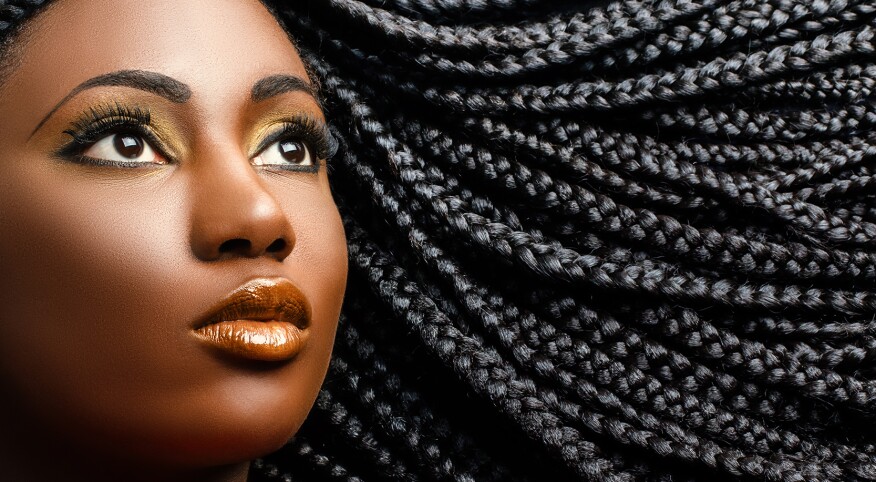Many sisters love donning braids for their versatility and simplicity, especially during the summer months. While meant to serve as a protective style, this elegant do is notorious for causing pain and tension for some wearers and can eventually lead to hair loss if braided too tight.
If this is the case for you, consider asking your stylist for knotless braids at your next salon visit. These braids look more seamless without the bulge at the root you would normally see with traditional braids — almost giving the illusion that the hair is growing out of your scalp. In recent years, knotless braids have grown in popularity, but the concept is nothing new, as women have been rocking them for years. Stylist and natural-hair expert Felicia Leatherwood, who has blessed the tresses of Issa Rae, Ava DuVernay and Jill Scott, tells Sisters all about the pain-free style you may wish you’d known about sooner.
They’re kinder to your strands
Knotless braids are installed without forming a knot at the base of the scalp. Instead, your stylist will gradually add small pieces of braiding hair to your natural hair. This is called the feed-in method. According to Leatherwood, this method affixes the braiding hair onto the scalp without the pulling and tugging that’s often experienced with traditional braids.
More flexible styling
Unlike with traditional braids, you have the freedom to achieve a variety of styles on day one of installation. “The way the hair is fed in at the base, it’s not creating the knot that’s restricting the movement of the braids,” explains Leatherwood. “So you can actually start to do a high ponytail the same day that you get your hair braided, instead of having to wait until your scalp finds relief from the tension.” After sitting in the chair for four to eight hours, this is a perk you can look forward to.
Proper maintenance is a must
Protective styles require a little extra TLC, and knotless braids are no exception. “The most important thing you can do when you have a protective style is to get a touch up [after two or three weeks] around the edges where the hair [may be] thinning,” says Leatherwood. “When those braids are hanging on by a thread, depending on how sensitive your edges are, it’s putting weight on the hairline that can eventually pull [your edges], especially if the braids are long and you get them caught in something or you lean on them during sleeping.” Two other things you can do to ensure your protective style is serving you well are oiling your scalp on a regular basis and sleeping on a satin pillowcase at night. Pro tip: Avoid color touch-ups while braids are installed. “You can get the color trapped at the base of the braid, and it can deteriorate the hair over time,” says Leatherwood.
Two oil options: My Black Is Beautiful Cooling Scalp Serum ($12.99, sallybeauty.com) and Mielle Rosemary Mint Scalp & Hair Strengthening Oil ($9.99, mielleorganics.com)
Two satin pillowcase options: Slip Pure Silk Pillowcase ($110, nordstrom.com) and Mulberry Silk Pillowcase ($48.99, hairfinity.com)
Do “knot” overdo it
Letting knotless braids overstay their welcome can be just as damaging to your hair and scalp as leaving in regular braids for too long. Leatherwood doesn’t recommend keeping them in any longer than five to six weeks. “If you don’t take the time to condition and let [your natural hair] breathe from the tension and the pulling, you’re going to create thinning, especially when we start to get gray, because the hair changes textures,” says Leatherwood. “So it’s really important to give [the hair] a break at least for two weeks in between [installations].” When it’s time to take your braids out, Leatherwood advises cleansing the scalp and hair afterward with a clarifying shampoo so that the hair follicles are stimulated, encouraging healthy hair growth. She also recommends using deep conditioner on the hair for 30 minutes with a plastic cap or under heat to restore moisture.
Two clarifying shampoo options: Kinky-Curly Come Clean Shampoo ($9.99, target.com) and As I Am Curl Clarity Shampoo ($10.99, sallybeauty.com)
Two deep conditioner options: tgin Honey Miracle Hair Mask Deep Conditioner ($17.99, ulta.com) and Camille Rose Algae Renew Deep Conditioning Mask ($19.99, ulta.com)

Getty Images










